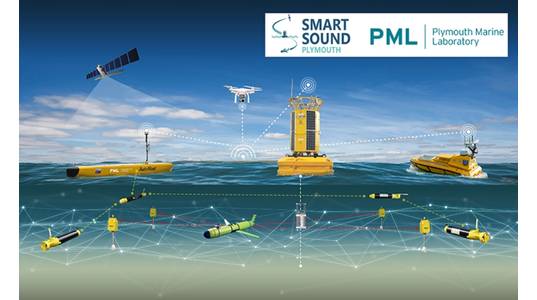
What has been described as a first-of-its-kind multi-million-pound fleet of innovative and interconnected marine technologies is soon set to be deployed off the coast of Plymouth, UK, according to Plymouth Marine Laboratory, a marine research institute.
An 8.5-meter-tall Autonomous Data Buoy featuring a set of onboard sensors will soon be deployed offshore as part of Smart Sound Plymouth’s plan to create a world-leading proving ground for high-tech marine innovation.
"Smart Sound Plymouth stretches over more than 1000km2 of ocean from sheltered bays to hostile offshore waters, providing an area for developing and demonstrating cutting-edge products and services for the marine sector. It is also home to the prestigious Western Channel Observatory, where a long-term data set, remote sensing and ecosystem modeling inform world-leading science," Plymouth Marine Laboratory said.
The new buoy, which will be deployed by Plymouth Marine Laboratory (PML) with support from the European Regional Development Fund (ERDF), provides a unique capability for the UK thanks to its autonomous water column profiling system, PML said.
"The profiler will deliver invaluable high-resolution data to scientists working on the Western Channel Observatory. Where the previous buoy systems only measured in surface waters, the new profiled datasets will deliver an unprecedented understanding of this dynamic area and its complex marine ecosystem. The advanced platform is built by Mobilis and provided through Hydrosphere UK," PML added.
Uncrewed surface vessel - AutoNaut
Alongside the buoy, Smart Sound’s fleet of ocean robots includes the recently named PML Pioneer, a five-meter AutoNaut uncrewed surface vessel which is propelled by wave motion and powered by three hundred-watt solar panels.
"The PML Pioneer, funded by the Natural Environment Research Council (NERC), is one of only two of its kind in the UK and will be the only one regularly deployed in UK waters. The integrated scientific payload is the most advanced to be deployed from an AutoNaut and includes state-of-the-art chemical sensors, and a photosynthetic efficiency and rate sensor," PML said.
PML has said it has also procured four autonomous underwater robots from ecoSUB robotics, with funding from NERC.
"Their sophisticated sensors are designed to provide crucial scientific data and the flotilla of new generation subs, the largest in the UK, is uniquely integrated together using acoustic underwater communications. This means the subs will be able to perform multi-vehicle synchronized surveys with accurate underwater positioning and can communicate with the PML Pioneer," PML added.
"Plymouth’s new fleet is unique in its field thanks to ‘Smart Sound Connect’, a £1.8M investment to deliver a high-speed above water communications network across which the vessels and equipment will be able to communicate with each other. This advanced 5G private marine network will extend over one mile south of Plymouth Sound and cover the port of Plymouth," PML added.
Private marine broadband network
Meanwhile, PML said, ‘Smart Sound Connect – Offshore' will deliver high-speed communications across the full extent of Smart Sound, some 20 miles south of Plymouth.
"This network will be a private marine broadband network, providing seamless integration into the 5G network. Smart Sound Connect is funded through the Local Enterprise Partnership (Heart of the South West LEP) and delivered through the Marine Business Technology Centre, Plymouth." PML said.
‘Smart Sound Digital’ will draw on the wealth of data being transmitted in real-time across this advanced communications system, to deliver a “digital twin” of the Smart Sound," PML added.
"This simulation of the natural environment, delivered by a large consortium of national partners led by PML and Plymouth City Council, will have numerous use cases, including advancing marine autonomy with a particular focus on port integration, certification and regulation. This will also enable partners to develop Smart Port technologies and link to Smart Cities, providing an integrated smart environment," PML added.
Smart Sound Plymouth is led by PML and delivered by a wide range of partners from the Future Autonomous at Sea Technologies (FAST) Cluster, which has over thirty members across industry, academia, and government collaborating to make Smart Sound unique, innovative, and accessible to all.
Dr James Fishwick, Head of Smart Sound Plymouth and Head of Operations and Technology, Western Channel Observatory said: “This is an incredibly exciting time for PML and Smart Sound. The combination of the new data buoy and the autonomous vehicles will give us unrivaled capabilities for this type of ocean observation. It’s a great example of UK tech and innovation, a success story for Plymouth as a hub for marine research and an opportunity to showcase how we can monitor the environment in a net-zero future.”